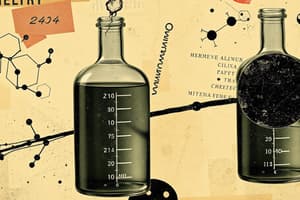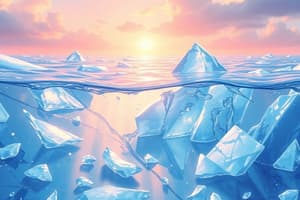Podcast
Questions and Answers
What is the melting point of pure water at 1.00 atm?
What is the melting point of pure water at 1.00 atm?
- 0°C (correct)
- 273.16 K (correct)
- 250 K
- 32°F
Why does ice float on water?
Why does ice float on water?
- Ice is less dense than liquid water. (correct)
- Ice is denser than water.
- Ice has a higher temperature than water.
- Ice maintains a tetrahedral structure.
What contributes to ice's high specific volume?
What contributes to ice's high specific volume?
- The presence of a liquid water layer.
- The tight packing of molecules in ice.
- The hexagonal lattice structure. (correct)
- The temperature during freezing.
What occurs during the crystallization of water?
What occurs during the crystallization of water?
What percentage of hydrogen bonds are broken when ice melts?
What percentage of hydrogen bonds are broken when ice melts?
What happens when water is supercooled?
What happens when water is supercooled?
What is the main reason for the relatively low latent heat of fusion of water?
What is the main reason for the relatively low latent heat of fusion of water?
What does the phase diagram of water illustrate?
What does the phase diagram of water illustrate?
What happens to the rate of non-enzymatic reactions during freezing?
What happens to the rate of non-enzymatic reactions during freezing?
What is a consequence of recrystallization during frozen storage?
What is a consequence of recrystallization during frozen storage?
Which factor is crucial for minimizing damage in frozen foods?
Which factor is crucial for minimizing damage in frozen foods?
How does cellular disruption affect enzymatic reactions during freezing?
How does cellular disruption affect enzymatic reactions during freezing?
What drives the growth of larger ice crystals during freezing?
What drives the growth of larger ice crystals during freezing?
What is the primary effect of low supercooling on the crystallization process?
What is the primary effect of low supercooling on the crystallization process?
Which process becomes dominant at much lower temperatures during crystallization?
Which process becomes dominant at much lower temperatures during crystallization?
How does fast cooling affect the number and size of ice crystals?
How does fast cooling affect the number and size of ice crystals?
What is the purpose of seeding in the crystallization process?
What is the purpose of seeding in the crystallization process?
What effect does freeze concentration have on the physical properties of food during freezing?
What effect does freeze concentration have on the physical properties of food during freezing?
What is the relationship between the degree of supercooling and the crystallization rate?
What is the relationship between the degree of supercooling and the crystallization rate?
Which statement best describes the effects of temperature on crystal growth during crystallization?
Which statement best describes the effects of temperature on crystal growth during crystallization?
What occurs in the remaining unfrozen water during the freeze concentration process?
What occurs in the remaining unfrozen water during the freeze concentration process?
Flashcards are hidden until you start studying
Study Notes
Unique Properties of Water and Ice
- Water can transition between liquid and solid states, forming ice, which is essential for various scientific and practical applications, particularly in food chemistry.
Melting Point of Water
- The melting point of pure water at 1.00 atm is 273.16 K (0°C).
- Upon freezing, water retains a tetrahedral structure similar to its liquid form.
Crystallization and Structure
- Water crystallizes into an open structure, resulting in ice being 91% as dense as liquid water.
- Lower density of ice allows it to float on water.
- Ice formation can disrupt tissue structures, which is particularly significant in biological and food contexts.
Hydrogen Bonding and Latent Heat
- Melting ice results in the breaking of only 15% of hydrogen bonds, leading to a relatively low latent heat of fusion compared to vaporization.
- Water remains highly structured even in liquid form due to partial retention of hydrogen bonds.
- Ice exhibits a hexagonal lattice structure, contributing to its high specific volume.
- When ice melts, hydrogen bonds break, and water molecules pack more densely, transitioning into the liquid state.
Phase Diagram of Water
- The phase diagram illustrates the conditions (temperature and pressure) for water to exist as a solid, liquid, or gas.
- Crossing equilibrium lines on the diagram indicates potential phase changes.
Crystallization Process
- Nucleation: Initial step where ice crystal nuclei form.
- Crystal Growth: Ice crystals develop around the nucleic centers.
- Water can be supercooled below its melting point (0°C) at atmospheric pressure, allowing unusual behaviors in phase transitions.
- Introducing a small ice crystal or solute can initiate nucleation in supercooled water, raising the temperature to the melting point.
Types of Nucleation
- Heterogeneous Nucleation: Occurs on foreign particles; it is the most common nucleation type.
- Homogeneous Nucleation: Involves nuclei formation from pure water molecules without foreign particles.
Importance in Food Chemistry
- Understanding water and ice properties is critical in food chemistry as they influence the quality and characteristics of food products.
Crystallization Process
- Crystallization of water into ice consists of nucleation and crystal growth stages.
- The process releases heat of fusion; removal of this heat influences the crystallization rate.
Nucleation and Crystal Growth
- Nucleation: Initial formation of ice crystal nuclei.
- Crystal Growth: Expansion of ice crystals around nucleation points.
Temperature Effects on Crystallization
- Supercooling degree affects crystallization rates significantly.
- Low Supercooling: Occurs near freezing point, leads to slower crystallization.
- High Supercooling: Involves significantly lower temperatures, resulting in rapid crystallization.
Impact of Cooling Rates
- Fast Cooling: High nucleation rate, slow crystal growth; results in many small ice crystals.
- Slow Cooling: Low nucleation rate, fast crystal growth; produces fewer, larger ice crystals.
Crystal Growth vs. Nucleation
- Crystal Growth is predominant near the freezing point.
- Nucleation dominates at lower temperatures.
Seeding
- Seeding introduces nuclei to liquids prior to freezing, promoting finer crystalline structures.
Importance in Food Science
- Crystalline structure in frozen foods is vital for quality.
- Ice formation can have negative effects like freeze concentration and cellular disruption.
Freeze Concentration
- During freezing, ice crystallization concentrates non-aqueous substances in remaining unfrozen water.
- Can alter properties such as pH, viscosity, and ionic strength.
- Increased concentrations of reactants can elevate reaction rates despite low temperatures.
Reactions During Freezing
- Non-Enzymatic Reactions: Rates can increase during freezing, including oxidative reactions.
- Enzymatic Reactions: Rate escalates due to cellular disruption, allowing enzyme-substrate interaction.
Recrystallization
- Occurs during frozen storage with temperature fluctuations, causing small ice crystals to merge into larger ones.
- This process deteriorates the texture and quality of frozen foods.
Minimizing Damage in Frozen Foods
- Importance of reducing ice formation and recrystallization to preserve food quality.
- Stable low temperatures are critical for decreasing reaction rates and maintaining food integrity.
Studying That Suits You
Use AI to generate personalized quizzes and flashcards to suit your learning preferences.




